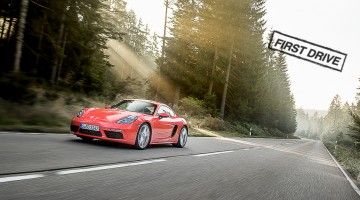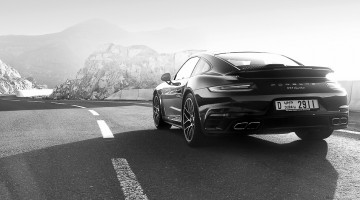The Evora is a machine that enlightens you with new perspectives on life and road. Play with the throttle for a bit and nothing else matters.
| Engine | Power | Torque | 0-100kph | Top speed | Kerb Weight | Basic price |
|---|---|---|---|---|---|---|
| 3.5 litre V6, supercharged | 410bhp @ 7000rpm | 301lb-ft (410Nm) @ 3,500rpm | 4.2 secs | 305kph | 1325kg (309bhp/ton) | $104,786 (AED 385,000) |
As far as I can see, there are only two downsides to the new Lotus Evora 410. The first one would be its air conditioning, which, despite being perfectly fine, is programmed to switch itself off when the engine’s revs run too high or too low. The second is that Lotus also provides this car with an (optional) automatic transmission and that, to purists like me, is nothing short of an obscenity. A Lotus – any Lotus – should have a manual gearbox.
Thankfully the version I’m trying out is so equipped, so let’s forget that and, instead, dig into the 1,325kg of pure joy the new Lotus Evora 410 undoubtedly is. Judged by its looks and its adherence to its maker’s core values, this is a flawless machine. Let your eyes dance across its purity of form, starting at the front with its pointed grille and slanted headlights – at once it’s both friendly and aggressive. Follow its lines over the shapely bonnet with its large air intakes and across the small windscreen and miniscule carbon fibre roof, which shelters the tiniest of cabins. A slight taper down over the carbon engine cover and we are pretty much done – there is no more car.
The Evora is a machine that enlightens you with new perspectives on life and the road. You sit so near to the ground that you never realised the Nissan Tiida is actually an SUV. And like anything worthwhile, it is difficult to get into. Literally. To enter you need to learn a dance move that combines a graceful sticking out of the derriere, a boxing head-bobbing move, and an extension of the arms, all in a falling cadence towards the seat. Once there you use the momentum to lift your feet and, with a twitch of the hips, turn towards the steering wheel.
Our test car has been supplied with really thin and hard bucket seats that are definitely not suited to XL humans, although more comfortable chairs are available as an option for non-masochists. With the buckets in situ, though, the car is ideally suited to the installation of five-point harnesses making the Evora 410 a potentially perfect track weapon. The seating position itself is perfect, with all necessary controls extremely close to hands and feet, and visibility is excellent.
Sadly it’s become a momentous occasion when you get into a car and realise it still requires a key to start, has a stick shifter and three pedals. But this Lotus is old school, as it should be, providing a mechanical connection to the engine and unfiltered feedback to your rear end, along with immediate responses and barely assisted steering. And let’s not forget to mention the noise. Oh, what a glorious noise.
The drive
On public roads you quickly find that speed bumps are really tall and that the paint used for road markings is really thick. That’s how hard the forged aluminium double wishbone suspension, anti-roll bar with Eibach springs and Bilstein dampers, combined with low profile tyres are. This also means that you are truly connected to the road and, thus, can discern what’s going on down there at every turn. No car connects with its driver quite like a Lotus.
Play around with the throttle for a bit and nothing else matters – you forget the rough ride and the hard seats. It’s been a very long time since I felt such an immediate connection between the pedal and the engine, where every millimeter pushed provokes a thump in the back. It is so precise that, with just a little bit of practice, you can shift gears without touching the clutch. Lovely.
Its engine alone deserves an entire chapter devoted to it. As the soul of the Toyota Avalon, Lexus LS, and RX350, it has a proven record of reliability and torque. Lotus has seen fit to supercharge the 3.5-litre, 24-valve V6, which pumps out 410bhp and 309lb ft of torque. Further, with the combination of the exhaust valve, which opens at 4,000rpm, and the compressor, it is a source of mechanical music that makes the audio system irrelevant. And as if all that wasn’t enough, it is visible both when lifting the carbon fibre tailgate, as well as through the rear view mirror.
One could argue that the six-speed manual transmission is a compromise between road and track use – it seems to have been set to ratios that accommodate both requirements and, as a result, I find that on normal road drives I’m shifting from fourth straight to sixth, while on track I doubt I would ever get to even use fifth. That said, the lightweight extruded aluminum chassis, clutch and limited slip differential make gear changes snappy and acceleration through turns an absolute joy.
I’ve run out of space to talk about the chronograph or the fuel efficiency but, let’s be realistic, none of those matter on a car like this. I should mention, though, that the Lotus is a true head turner. I have to mention, too, that the sport brakes are AP Racing items with four-piston calipers and they are relentless. The interior is an explosion of Alcantara and the colour matching on the interior plastic bits is a classy detail. I’ll stop now before I get carried away again.
There’s hardly a better place to put the $104,786 (AED 385,000) it costs. Sitting in a segment dominated by the 911, it offers performance equivalent to a Carrera S and is significantly less expensive. And trust me when I say that the feel, cornering speed and sheer joy of driving the thing is comparable, if not superior. The 911 is more digital and in-tune with the times, but the unashamedly analogue Evora 410 is nothing short of ambrosia for the connoisseur.



